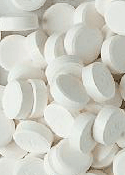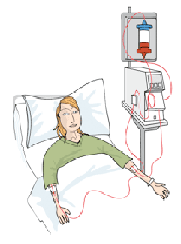|

Ulcerative Colitis
Treatment plan for ulcerative colitis
Medications available
 There are four major classes
of medicines that are used to treat ulcerative colitis. Details of how they work, when they might
be used, and possible considerations are outlined below. There are four major classes
of medicines that are used to treat ulcerative colitis. Details of how they work, when they might
be used, and possible considerations are outlined below.
Class of
Medicine:
5-ASAs (5- aminosaliclic acid)
Type of ulcerative colitis treated:
Mild Moderate
How it works:
Anti-inflammatory medication
Formulation:
Oral (tablet), Rectal (enema or suppository)
Benefits:
Relief in 4–8 weeks. Without inflammation, diarrhoea, rectal bleeding
and pain are reduced. Considered safe when used long-term
Side-effects:
Generally considered safe
Examples:
Mesalazine, Balsalazide, Olsalazine, Sulfasalazine
Class of
Medicine:
Corticosteroids
Type of ulcerative colitis treated:
Moderate
Severe
How it works:
Reduces
inflammation (suppresses the immune system)
Formulation:
Oral
(tablet), Rectal (enema), Intravenous (injection)
Benefits:
May bring relief in 1–3 weeks. Remission may be reached in 6–8 weeks
Side-effects:
Side
effects (elevated blood sugar, high blood pressure, cataracts,
osteoporosis) mean that medication is not safe for long-term use
Examples:
Prednisone, Methyl prednisolone (oral), Triamcinolone, Budesonide
(rectal)
Class of
Medicine:
Immuno-suppressants
Type of ulcerative colitis treated:
Maintenance of remission in refractory patients*
How it works:
Reduces
inflammation (suppresses the immune system)
Formulation:
Oral
Benefits:
May bring relief in ~3 months. Often taken in conjunction with other
medications
Side-effects:
Myelosuppression (lowering of the bone marrow’s ability to make
platelets and blood cells), risk of infection, inflammation of pancreas
and liver. Regular monitoring is essential
Examples:
Azathioprine, 6-mercaptopurine (6-MP)
Class of
Medicine:
Biological therapies (Anti-TNFα)
Type of ulcerative colitis treated:
Moderate
Severe
How it works:
Reduces
inflammation (antibodies block specific molecules in the inflammation
process)
Formulation:
Injection
(home), Intravenous (hospital)
Benefits:
Relief in 2–4 weeks
Side-effects:
Before taking medication, you should be screened for tuberculosis
(either by chest X-ray and/or skin test). Risk of infection (although
lower than with corticosteroids), hypersensitivity reactions (joint
pain, transient reaction or fever), heart failure (in elderly patients –
check for swollen ankles and shortness of breath) or skin disorders.
Examples:
(In Europe:) Infliximab
*Patients who do not respond to standard medications
Medical devices
Apheresis (leukocytapheresis)
Cells of the immune system called white blood cells (or
leukocytes) defend the body against infections. In people with active
IBD types of leukocytes called granulocytes and monocytes are often
increased or over active. Large numbers of these cells enter the wall of
the intestines and can release substances that cause bowel injury and
stimulate inflammation. It is believed that the watery diarrhoea seen in
severe IBD is a result of injury to the absorptive epithelium which
makes it unable to absorb water.
 Apheresis,
or leukocytapheresis, is performed with a
medical device that selectively binds excess or activated granulocytes
and monocytes from the blood. Blood is pumped from a vein in one arm
(via a simple venopuncture) through a column containing cellulose
acetate beads or a filter. This binds granulocytes and monocytes while
the rest of the blood passes right through and is infused back into the
body through the other arm. The outcome is a reduction in the number of
inflammatory cells that can move from the blood into the intestinal
wall. As a result, the symptoms of IBD are relieved, and the bowel gets
a chance to heal. Apheresis,
or leukocytapheresis, is performed with a
medical device that selectively binds excess or activated granulocytes
and monocytes from the blood. Blood is pumped from a vein in one arm
(via a simple venopuncture) through a column containing cellulose
acetate beads or a filter. This binds granulocytes and monocytes while
the rest of the blood passes right through and is infused back into the
body through the other arm. The outcome is a reduction in the number of
inflammatory cells that can move from the blood into the intestinal
wall. As a result, the symptoms of IBD are relieved, and the bowel gets
a chance to heal.
The treatment lasts for 1 hour and is usually given once a
week for 5 weeks. It can be performed in hospital or in an outpatient
setting.
Leukocytapheresis involves mainly adults with IBD – there is
some debate as to whether it is suitable for children. It can be used to
reduce symptoms during a severe flare up, or in moderate to severe
active IBD in which satisfactory effects have not been achieved with
corticosteroids or other immunosuppressive therapy.
Some temporary side effects can occur, such as low blood
pressure, palpitations, and hot flushes; however, little is known about
the long-term side effects of apheresis.
The biological processes through which leukocytapheresis
affects the course of disease remain largely unknown, and it is
difficult to draw conclusions from the existing clinical trial data on
how effective the treatment really is.
|



